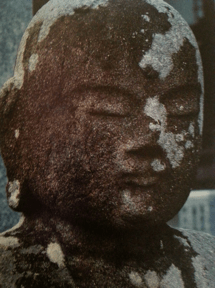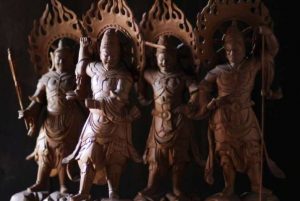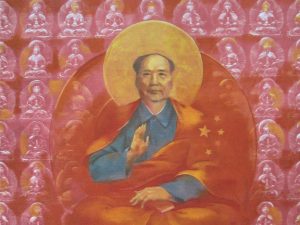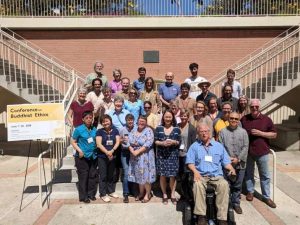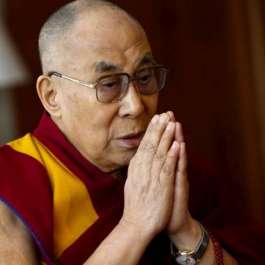
In Japanese temples or along the sides of roads, small stone statues of the Buddhist deity Jizo are a common sight. According to Japanese Buddhist beliefs, Jizo (Skt. Kshitigarbha) is a bodhisattva, a compassionate enlightened being, who is uniquely able to descend into Hell to rescue souls, and particularly those of children. In both paintings and sculptures, he is depicted with the shaved head and robes of a monk, and wears a benevolent expression. The stone figures are typically adorned with red bibs and caps or children’s clothing, and often serve as a memorial to children whose lives were taken away too soon.
On 6 August 1945, the lives of thousands of children and adults in Hiroshima were cut short when the US military dropped the first atomic bomb in an attempt to end World War II. Despite the fiery devastation of the city and the death of tens of thousands of citizens, a number of small Jizo statues in temples around Ground Zero survived. These statues are the subject of a book, Silent Witnesses: Hiroshima’s Hibaku Jizo, published in 2013 by Hiroshima photographer Ken Shimizu. His touching images of this gentle deity are all the more poignant when we consider how closely Hiroshima resembled Hell on Earth 70 years ago this week.
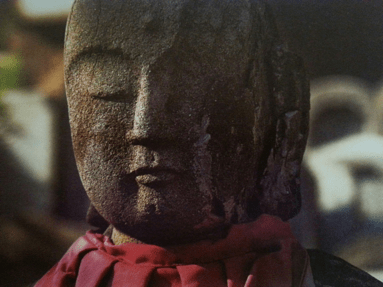
Shimizu, who was born in Hiroshima five years after the bomb was dropped, has many memories of the scars of the atomic bombing on his native city. His childhood recollections include the burned stairs of a department store, the shadow burnt onto the wall of a bank, and the story of young Sadako Sasaki, who had become ill with leukemia because of the bomb and folded 1,000 origami cranes in the belief that this would grant her wish to be healed. In 1975, when he returned to the city after attending college in Tokyo, Shimizu began photographing traces of the bombing. It wasn’t until 2009, however, when he was guiding a friend around the A-bomb Dome in the Peace Memorial Park, that he came across some very haunting evidence of the explosion—a small Jizo figure wearing a red bib in the nearby temple, Sairen-ji. The surface of the figure was rough and had black burn marks from the intense heat of the bomb blast; only the area below the robes remained smooth as it was sheltered from the explosion. Shimizu remembers thinking, “This Jizo recalls perfectly what happened on August 6, 1945, and he is trying to tell us about it” (Shimizu 2013, back cover flap).
The scarred statue at Sairen-ji compelled Shimizu to search for more of these stone hibakusha, or “survivors of the bomb.” He spent four years tracking them down, and found them at a number of temples throughout the city. Becoming increasingly fascinated by these stone representations of the compassionate Buddhist deity that had borne silent witness to the devastation of his home city—which are therefore known as “Hibaku Jizo”—he decided to capture the “memories” of the statues by photographing them. At first glance, some of the figures in the photographs appear to have been ravaged by time or by Japan’s capricious climate. However, on close inspection, it is apparent that the damage was not natural but instead caused by the heat or force of the atomic blast. Some figures have rough or darkened surfaces due to the heat, while others are cracked or have crumbled faces. Some have lost their heads entirely (later lovingly replaced by people from the neighborhood). One has a crack on his face that resembles a keloid, or raised scar. To Shimizu, the Jizo figures seemed to have received some of the same wounds—the burns, the keloids, and the missing body parts—as the people of Hiroshima. Through his photographic portraits of these Jizo figures, Shimizu portrays the pain, grief, and terror of Hiroshima’s inhabitants, whose trauma was unlike anything humans had previously experienced.

Shimizu’s Hibaku Jizo project culminated in 2013 with the publication of his book and an exhibition of the photographs at the Japanese Community and Cultural Center in Little Tokyo, Los Angeles. His hope was that the silent messages of these Jizo figures would “speak to Americans as well and that together we can make a world without nuclear weapons.”* The serene yet often pained expressions on the faces of the Hibaku Jizo suggest that these bodhisattvas have truly experienced a journey to Hell and survived. These figures may not have saved the residents of Hiroshima 70 years ago, but Shimizu’s poignant images (shared with the world through his book and exhibitions of his photographs) will help remind people of the horrors of the nuclear explosions in Japan so that no other humans ever have to suffer such devastation.
This article is dedicated to the memory of Ken Shimizu, who was determined to help bring peace to the world. He passed away in February 2015.
*2013 / Hiroshima photographer discovers “Jizo” stone figures which survived A-bomb
References
Shimizu, Ken. 2013. Silent Witnesses: Hiroshima’s Hibaku Jizo. Hiroshima.



